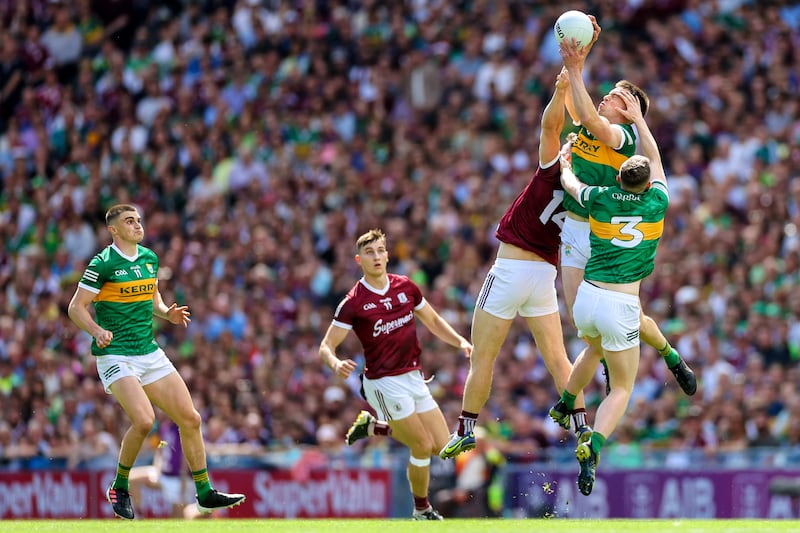Jim Gavin’s Football Review Committee (FRC) are looking at another couple of potential changes to the rules of football, including a new ‘result on the day’ protocol, which would, if accepted, replace the penalty shoot-out and even serve as an alternative to extra-time.
The chair of the FRC briefed media representatives in Croke Park on Tuesday morning on progress being made in the quest to improve football “as an experience for players and spectators”. To date, the ambitious timetable laid out in June is still on track to deliver proposals for rule change to a special congress on November 30th.
The successful rule changes will be implemented at all levels, including next year’s league and championship. After the 2025 intercounty season, there will be a final review with a view to putting in place any further tweaks for 2026. Once that takes place, the committee will stand down.
It was accepted that some possible changes, for example a redefined tackle, would not be looked at until next year.
Seán Moran: Ratios shift ominously as the GAA fights to hold its audience
Decision on Ulster quarter-final venue put off as Antrim double down on Corrigan Park
Proposal to allow GAA clubs make facilities available to other sports to be voted on at Congress
Aidan Forker set for two-game suspension after red card for headbutt on Michael Murphy
Gavin’s presentation dealt with “emerging themes” which aren’t finalised proposals but possible solutions under consideration to address concerns about the game.
They are the product of intense deliberation, with 31 meetings of the committee, drawn from former players and managers listed below, 19 online and 12 in person plus consultation with various stakeholders and engagement with thousands through online surveys and questionnaires.
There have also been five sandbox games – protected trial matches – with more planned before the motions are drawn up for presentation to congress.
The “overtime showdown” is designed to provide an in-play alternative to penalties: it provides for the first score in extra time to trigger an entitlement for the losing team to have a restart and try to work an equaliser. If they fail and the ball goes dead, the match is over.
If they succeed, the next score wins.
There has been some tweaking to other ideas. The one-v-one throw-in at the start of a half is still under consideration, but the non-competing centrefielders will stand just outside the field of play either side of a halfway line, the introduction of which is also being looked at.
This was adapted from a previous suggestion that the two surplus centrefielders would wait outside the 45. Trial matches suggested that they were racing into contact as soon as the ball was thrown in.
There has also been a tightening of the penalty for some head-high challenges, on the advice of the Medical, Scientific and Welfare Committee. Whereas in June’s update, the infraction was being assessed as meriting a yellow card, now it specifies that “head-to-head contact” is an immediate red.

Otherwise, the themes are familiar from the initial presentation three months ago.
The two most radical are the obligation for both teams to keep three players inside each 65 and the introduction of a two-point score for kicking over the bar from outside a 40-metre arc (the radius centred on the midpoint of the goal line, and arcing back to the 20m line).
Anywhere inside the arc or the 20m line would still be worth one and it is the FRC view that a 45m kick, as currently exists, would continue to count as 0-1.
A goal will be worth four points.
Both teams will be required to keep three outfield players within the 65m line. Goalkeepers will continue to be allowed play out of goal but can receive a pass from a team-mate only when in their own ‘square’ or when past the halfway line.
The forward or advanced mark will continue but a player will be entitled to play on until no advantage is accrued and then go back for the original mark. Similarly, the advantage rule will be applied as in rugby by playing on until no advantage has accrued and then going back for then original free, but there will be no ‘five seconds’ rule.
The countdown clock is being considered. It would be administered by a fifth official on the signal of a referee, as in women’s football. Linesmen (referred to as ‘line umpires’) will be empowered to bring foul play to a referee’s attention immediately and not at the next break in play.
Vanishing foam may be used as a way to curtail players stealing metres, for frees inside the 65m line.
There is interest in a fifth black card infraction, the tactical foul of holding someone back from getting involved in the play.
The existing rule on “contributing to a melee”, an infraction that has been run ragged by lawyers at the Disputes Resolution Committee, is being defined as joining the fracas but not to remove a team-mate from the fray.
There will be final sandbox matches on October 18th and 19th in Croke Park when interprovincial teams will compete under the finalised proposed changes.
FRC: Jim Gavin (Dublin; chair), Séamus Kenny (Meath; secretary), Colm Collins (Clare), Patrick Doherty (Westmeath), Éamonn Fitzmaurice (Kerry), Shane Flanagan (Kildare), James Horan (Mayo), Alec McQuillan (Antrim), Michael Meaney (Carlow), Michael Murphy (Donegal), Colm Nally (Louth), Malachy O’Rourke (Fermanagh).
















